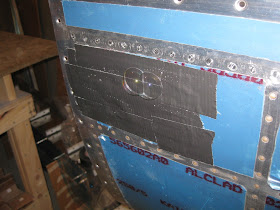I decided to redo my fuel tanks. See here for why. The entries specific to the redone tanks are here.
Time for pressure testing the right tank. Tip: Use pretty smelling soap as your bubble-maker. I prefer the lavender scent to sealant. A simple small paintbrush helps apply the soap.
After trying to use the clamps the kit comes with, I decided to get something smaller. The kit's clamps were too big and awkward to tighten.
Pump it up until the balloon inflates. It took a good 20 pumps for this to happen, even after pre-stretching the ballon. On one instance, I felt like I was pumping a lot of air in and yet the balloon would not inflate. So I pulled the balloon body with my hands and pfffft, it inflated!
Leak around the balloon seam. No biggie. I removed this balloon and used another one without the wire tie.
Leak around at the cap as indicated by the tape seal (I was able to isolate the filler flange and its rivets). No biggie? The plans suggest it isn't a problem. If it is perhaps I'll need to get a new o-ring for the locking cap.
Leak around this fitting. Thankfully, it's not the flange. This fitting just needs to be removed, have some Loctite put on it, then reinstalled. I didn't apply any thread sealant on it originally. Whoops.
For orientation, that's the upper fitting the plans have us drill the hole for. I was curious what it was for. Perhaps another finger strainer for inverted flight (that sounds fun...um, no it doesn't)? I asked the guys at Van's and Sterling said it was for a future fuel return line if needed. Does this mean they thought of everything? Seems like it so far.
So, all-in-all, the right tank had effectively no leaks (once I thread-seal that upper fitting). In retrospect, that isn't surprising. I took a very liberal approach to sealant. If I were to do the tanks over again, I would not use the deeper dimple dies (dice?) and I would dimple the baffle flanges and the associated skin holes rather than countersink. Threads abound on that latter subject, but here's one.






No comments:
Post a Comment